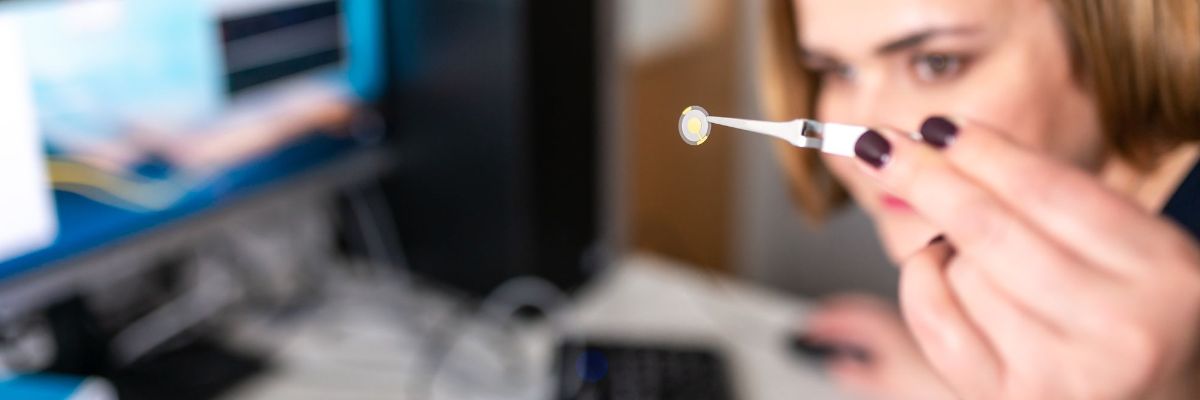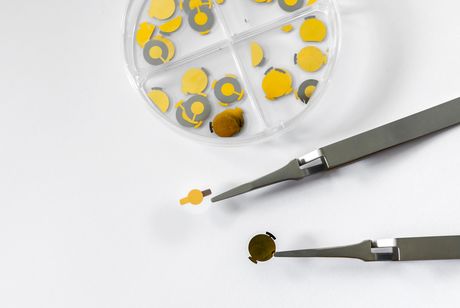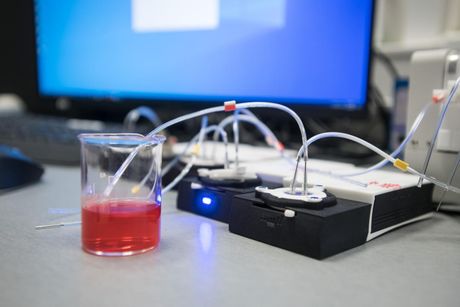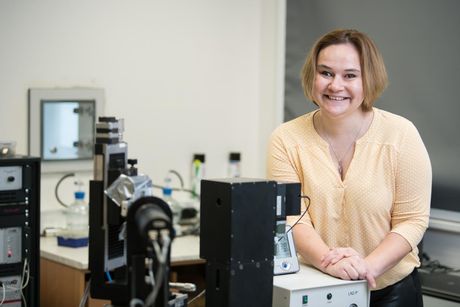
The Czech scientist’s biochip proved to detect coronavirus fast and reliably
26. 01. 2022
Confirmed: the biochip is as fast as an antigen test and at the time as reliable as the PCR method. A team of Czech scientists led by Hana Lísalová has achieved the most crucial milestone in the development of their unique system for the detection of the SARS-CoV-2 virus causing COVID-19. The research of the biosensor, which the system is based on, thus opened new options for further development in this area.
It looks like a little rounded metal sheet. The biochip is the heart of a biosensor that combines physical, chemical, and biological principles. The breakthrough technology detects not only a protein or the virus’s RNA as the current tests but both of them at the same time.
“That way, we combine the advantage of antigen tests and the reliability of the PCR method,” says Hana Lísalová, the leader of the research team from the Institute of Physics of the Czech Academy of Sciences (CAS). “It may bring a significant simplification of detection processes in the future.”

Unique technology: polymer, antibodies, and N-protein
The scientists covered the functional biochip with a thin layer of polymer. Antibodies that specifically capture the SARS-CoV-2 virus are then bound to it. As a result of this special, so-called anti-fouling property, the other particles are not caught on the biochip and are washed away.
The new method also brings a more preferable solution for testing the presence of the ever-changing virus in a sample. The respective antibodies bound to an anti-fouling brush respond to the viral N-protein. N-protein, however, is more abundant and not affected by the mutations that much compared to S protein. Thus, the method is not significantly affected by various viral mutations.

Unique technology: polymer, antibodies, and N-protein. The breakthrough technology combines physical, chemical, and biological principles.
It also benefits from the absence of sample modification, where the detected N protein forms complexes with viral RNA, so the signal is naturally amplified. This method is thus also significantly faster compared to conventional PCR tests, in which it is necessary to first isolate the viral RNA.
Already working
The scientists have already tried the biochip when testing the Prague public transport safety earlier in 2021. It proved similar sensitivity and reliability as the PCR method and confirmed that the public transport means are not the source of covid-19 infection.
The scientists also work in cooperation with CARDAM Solution on a robotic system which resembles a reversed coffee machine. Instead of taking a cup of coffee, people will insert a cup of liquid they previously gargled in their mouths. The machine takes the cup and within few minutes it will give back the result, with no need for medical staff.
A transformed idea
“The results of our current research were preceded by years’ long work on the development of biochips intended for the detection of other pathogens, such as the ones causing hepatitis or E. coli. After the outbreak of the COVID-19 pandemic, we came up with the idea to use it to detect the SARS-CoV-2 virus,” explains Hana Lísalová.

Hana Lísalová, the leader of the research team from the Institute of Physics
The method results from the collaboration of the biophysicists with teams from the Biological Centre of the CAS and the University of South Bohemia in České Budějovice. The outcomes have now been verified and published by the ACS Applied Materials and Interfaces Journal.
“The great results in this research could have been achieved only thanks to the great commitment of the top scientists in the interdisciplinary team. It is interdisciplinarity that can promote the results of scientific research to even greater social impacts,“ says Alexandr Dejneka, the head of the Division of Optics of the Institute of Physics of the CAS. Cooperation with other research institutes in the Czech Republic and abroad proved to be crucial. “It was mainly the collaboration with the team of An-Suei Yang from Academia Sinica (Taiwan) that developed and subsequently provided the respective antibody,” closes Hana Lísalová.
Text: Eliška Zvolánková, Division of External Relations, CAS Centre of Administration and Operations; Klára Horová, Institute of Physics of the CAS
Photos: Institute of Physics of the CAS; Jana Plavec, Division of External Relations, CAS Centre of Administration and Operations
Read also
- Let’s be ambitious, say leaders of the Dioscuri Centers at the Academy
- From farm to trash – food waste and what we can do about it
- New type of contrast agent will help with early detection of covert diseases
- Revolutionary method pioneered by Czech scientists reveals chromosome structure
- Citizens of no man’s land
- How to repair the spinal cord: Kristýna Kárová explores nerve cell recovery
- Bohemian Paradise Apples – The Station of Apple Breeding for Disease Resistance
- Plants contain an incredible wealth of chemicals, Tomáš Pluskal says
- Two dozen young scientists received the Otto Wichterle Award
- Threads of history: what can archaeological textiles reveal?
The Czech Academy of Sciences (the CAS)
The mission of the CAS
The primary mission of the CAS is to conduct research in a broad spectrum of natural, technical and social sciences as well as humanities. This research aims to advance progress of scientific knowledge at the international level, considering, however, the specific needs of the Czech society and the national culture.
President of the CAS
Prof. Eva Zažímalová has started her second term of office in May 2021. She is a respected scientist, and a Professor of Plant Anatomy and Physiology.
She is also a part of GCSA of the EU.